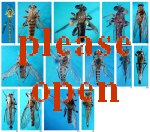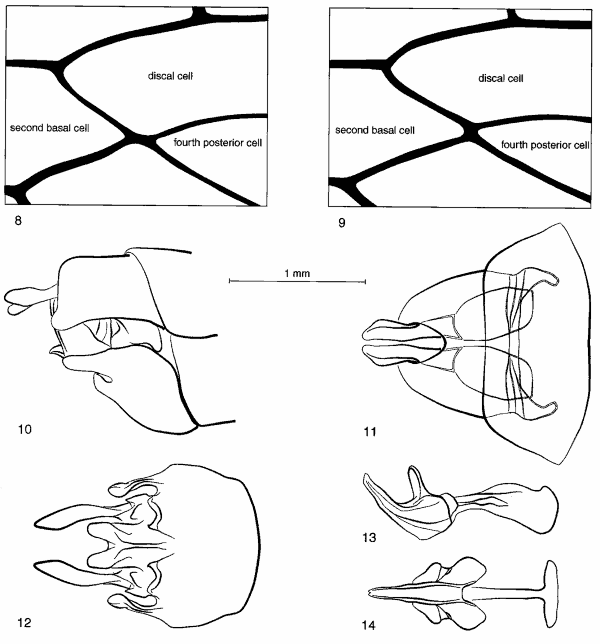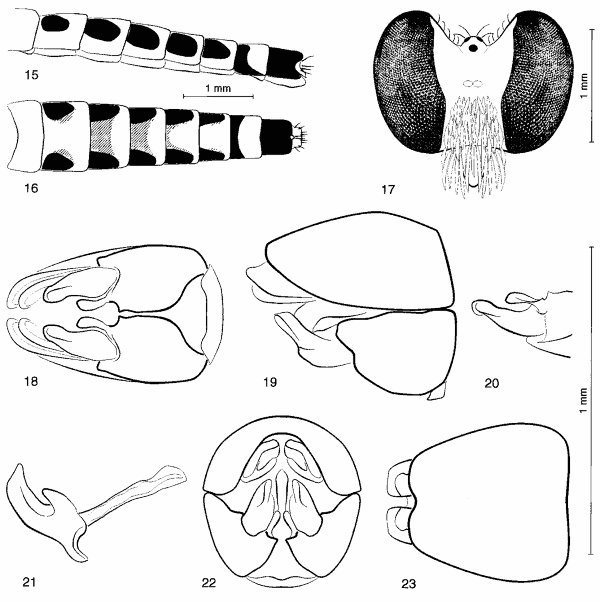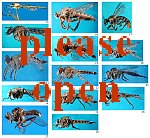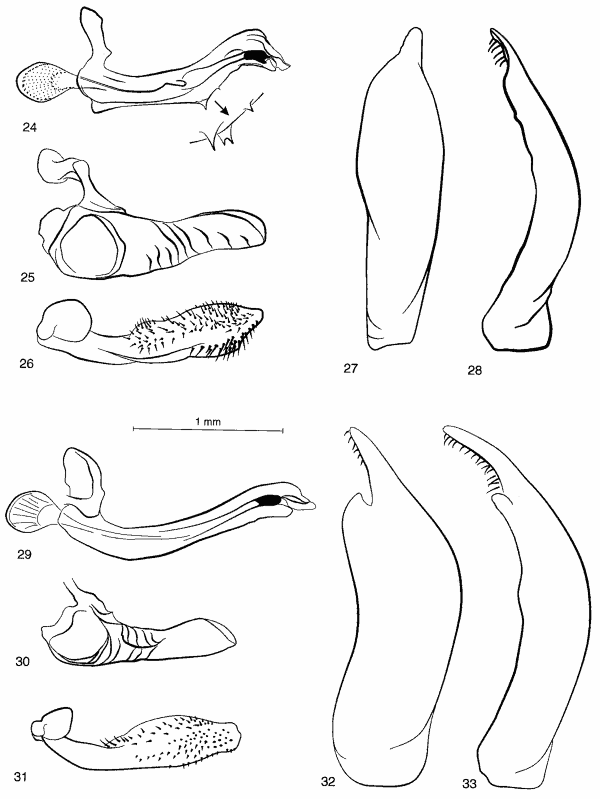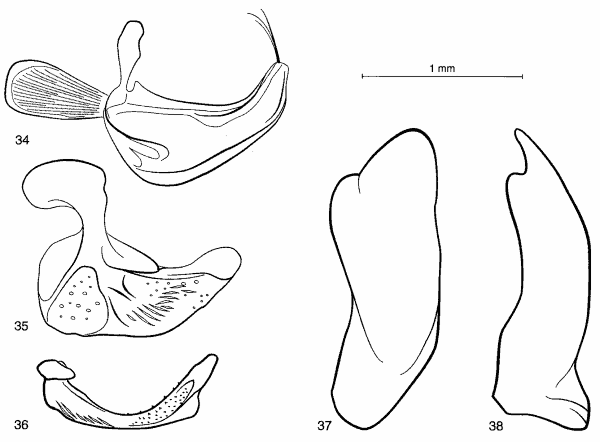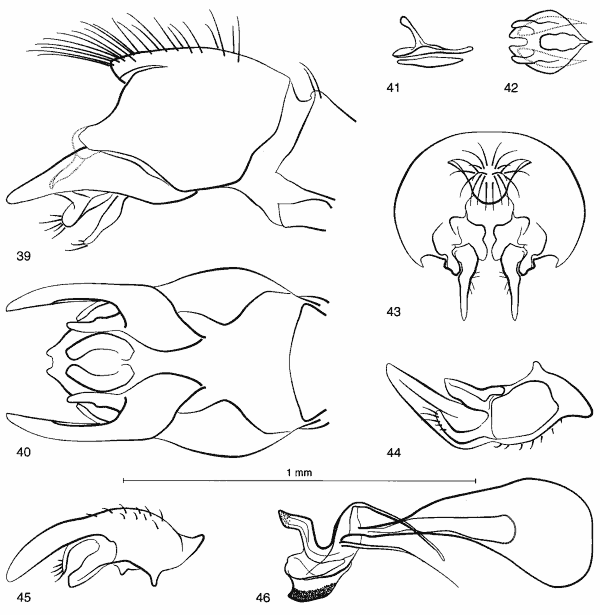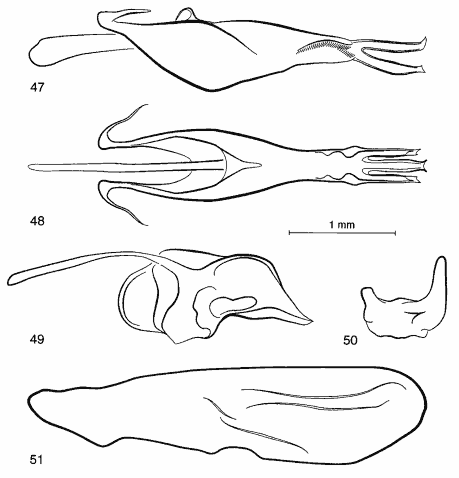Robber flies (Diptera: Asilidae) of the Fritz Geller-Grimm A b s t r a c t: New asilid specimens were collected during zoological field trips to the Socotra archipelago between 1998 and 2000. Four new species are described from the Socotra archipelago (Trichardis pohli n. sp., Rhadinus socotrae n. sp., Tolmerus socotrae n. sp., and Tolmerus wraniki n. sp.). Clinopogon sauteri Bezzi, 1910 is synonymised with Clinopogon nicobarensis (Schiner, 1868) and Tolmerus unicus (Becker, 1910) is removed from the genus Cerdistus Loew, 1849. Males of Trichardis nigrescens (Ricardo, 1903), Tolmerus unicus, and Ommatius tibialis Ricardo, 1903 are described with illustrations of male genitalia. The number of species known from the Socotra archipelago is increased from 4 to 12, including one unclassified species each of Microstylum Macquart, 1838 and Cerdistus Loew, 1849. Additionally, the record of Apoclea femoralis (Wiedemann, 1828) from Aden was verified.
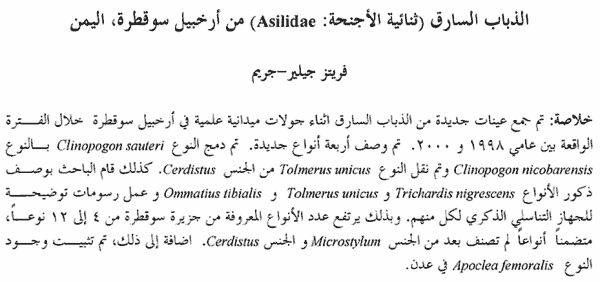
INTRODUCTION
Robber flies (Diptera: Asilidae) belong to the lower brachycerous Diptera and are distributed worldwide with more than 6800 described species. While the larvae of many genera live in soil, those of the Laphriinae and Laphystiinae usually occur in decaying logs and stumps, where they are predators of the larvae, and pupae of other insects. Adults are noted for their rapacious attacks on other insects, incuding stinging insects such as bees and wasps.
MATERIAL AND METHODS
The 98 specimens of Asilidae studied are from Socotra archipelago and South Yemen. The specimens were collected by Dr. Hans Pohl (Rostock), Dr. Wolfgang Wranik (Rostock), and Kay Van Damme (Ghent). Except for some duplicates in the collection of the author, all other specimens are deposited in the collections of CWWR, HLMD, NHCY and ZMHB.
In order to correctly identify species, sclerotized parts of the male genitalia were macerated in cold 10% KOH for about 24 hours at 30° C. The parts were then separated and placed in glycerine. The drawings and measurements given in this paper were made using a stereoscopic microscope, an ocular micrometer, a digital camera system and various graphic software.
Abbreviations:
SYSTEMATIC ACCOUNT
Subfamily Leptogastrinae
S p e c i m e n s e x a m i n e d: Yemen, Socotra Archipelago, Socotra Island: 1 female, coast road, coastal sand dunes, granite, sandstone, 12°36'N 54°21'E, 04.-06.II.1999, H. Pohl, SOQ-07, COGG; 1 female, Diksam, camp, 12°31'N 53°57'E, 26.-27.X.2000, H. Pohl, SOQ-2000/11, HLMD-Dip-251. D e s c r i p t i o n o f f e m a l e: Head black. Face about 0.24 times as wide as eye, slightly convex. Face and frons with silvery tomentum. Mystax yellow, restricted to single row on oral margin. Face, ocellar tubercle, and postcranium lacking hair. Occipital bristles yellow, in single row. Post-genal beard yellow. Palps yellow, with yellow hairs. Antennae yellow, style somewhat darker at apex, with yellow hairs; ratio of segments (first : second : third : style) 1 : 1.7 : 5.0 : 3.3. Thorax brown and yellow. Pronotum yellow, with silvery tomentum. Mesonotum with brownish tomentum, except for median stripe and lateral sclerites, which are silvery tomentose. Humeral calli yellow. Bristles: 1 yellow notopleural and 1 black supraalar. Short hair on mesonotum yellow,
- - - - - - - - - - - - - - - - - - - - - page 469 - - - - - - - - - - - - - - - - - - - - -
restricted to lateral sclerites. Pleurae brown and yellow mixed, with silvery tomentum (appears golden compared to ground colour). Hair on pleurae yellow; postnotal fan with yellow hairs. Scutellum yellow, silvery tomentose with few yellow hairs on hind margin.
Subfamily Laphriinae
Laphria brachyptera Loew, 1851 [based on female]. - Oldroyd 1970: 244; Oldroyd 1974: 109. Dasythrix stenura Loew, 1858. - Oldroyd 1970: 244; Oldroyd 1974: 109. Dasythrix ruficornis Wulp, 1899: 91 n. syn. [previously recorded as a synonym of Ctenota molitrix Loew, 1873, by Engel (1930: 234)]. S p e c i m e n s e x a m i n e d: Yemen, Socotra Archipelago, Socotra Island: 1 female, E of Hadibo, near Suq, approx. 12°26'N 54°01'E, 28.X.2000, H. Pohl, HLMD-Dip-252. D i a g n o s i s: The species has been sufficiently characterized by other authors such as Loew (1851) and Oldroyd (1970, 1974). On the studied specimen the mesonotal bristles are mixed, black and yellow (some of the notopleural, supraalar, postalar, dorsocentral and acrostichal bristles are black), which differs from specimens collected by Wulp (1899). R e m a r k s: Oldroyd (1970) commented: "Whether the specimens [of N. infumata] in the British Museum from Malawi, Tanzania and Kenya are strictly conspecific is a matter for future studies". The specimen from Socotra was compared with specimens of N. infumata from South Africa and Namibia. No differences could be observed; also they match the description of Dasythrix ruficornis Wulp, 1899, except for the colour of some bristles on mesonotum. Wulp (1899) noted that: "This species seems to be closely allied to D. brachyptera, Loew, but I cannot unite them, the hairs and bristles in the Aden species being without exception whitish, whereas in D. brachyptera black bristles are mingled with the white." The colour of the bristles is also variable in specimens from Southern Africa. N. infumata has been recorded from South Africa, Namibia, Tanzania, Zimbabwe, Mozambique, and Kenya.
- - - - - - - - - - - - - - - - - - - - - page 470 - - - - - - - - - - - - - - - - - - - - -
Subfamily Laphystiinae
S p e c i m e n s e x a m i n e d: Yemen, Socotra Archipelago, Socotra Island: 1 male, 1 female, Goeeh, 240 m, 12°32'N 54°10'E, 23.X.2000, H. Pohl, HLMD-Dip-253; 1 female, same data, COGG; 1 female, Firmihin, 12°24'41''N 54°13'35''E, 24.-25.X.2000, H. Pohl, HLMD-Dip-254; 1 female, Diksam, approx. 300 m, 12°32'298''N 53°56'102''E, 26.X.2000, H. Pohl, HLMD-Dip-255; 1 male, Homhil, spring with Ficus, 12°34'13''N 54°18'32''E, 29.-30.X.2000, H. Pohl, HLMD-Dip-256; 1 male, same data, COGG; 1 male, 1 female, Homhil, 12°32'N 53°56'E, 09.I.1998, W. Wranik, CWWR; 1 male, same data, COGG. D e s c r i p t i o n o f m a l e: Head black, 1.6 times as wide as high. Face about 0.6 times as wide as an eye, slightly projecting ventrally, with a small tubercle. Face and frons with silvery to brownish tomentum. Mystax black and white mixed (with predominantly black bristly hairs in middle), reaching antennal sockets. Face with white and black hairs laterally, which are longer above the antennal sockets. Ocellar tubercle large; with black and white hairs. Postcranium with black hair, laterally white. Occipital bristles strong, black, in 2-3 rows (laterally longer). Post-genal beard white. Palps black, with black hairs. Antennae black, with dark brownish tomentum, with black and white hairs and bristles; ratio of segments (first : second : third) 1 : 0.7 : 2.7. Segment 3 dorsally and ventrally with black bristles. Style minute, based on a small groove (Fig. 1). Thorax black. Pronotum without tomentum and with predominantly white hair. Episternum with black hair. Prosternum fused. Postmetacoxal bridge membranous. Mesonotum without tomentum, except a small border in front of scutellum, which is silvery tomentose. Humeral calli black with yellow and black bristly hairs. Strong bristles from transverse suture to base of scutellum black; 3-4 dorsocentral bristles black. Short hair on mesonotum yellow, longer and erect hair predominantly black. Pleurae black, silvery tomentose, except the lower half of mesopleuron and the center of sternopleuron, which are shining (tomentum forms a cycle, with a unique tomentose tuft on mesopleuron). Hair on pleurae predominantly white. Anepisternum with black bristle. Postnotal fan with black hairs (in some specimens black or yellow). Scutellum black, silvery tomentose at base; with yellow hair on disc and predominantly yellow hairs on hind margin. Wings slightly brownish, microtrichia covering wing surface. Costa with black hairs. Venation: Vein R2+3 bent anteriorly at tip and joining vein R1 at costa; first and fourth posterior cells closed and stalked; costa stops at the beginning of anal area. Halteres yellow. Legs black with predominantly white hairs and black and white bristles. Hind femora somewhat swollen, without ventral tubercles. Abdomen completely black, except the apical segment and genitalia, which are red in half of the specimens. 6 visible segments. Tergites shiny, with triangular spots of silvery tomentum at the posterior angles of tergites 1 - 5 (sometimes difficult to see as hair is so dense). Short hair on disc black, white and longer laterally; with white lateral bristles on tergites 1 – 3 at posterior corners. Sternites black; with brownish tomentum and long, white and erect hairs. Male genitalia rotated by 90°, red (or black in some specimens), with black hair; ventral border of epandria with flattened, strong bristles (Figs 2-4). Body length 10.0 mm, wing length 6.8 mm. D e s c r i p t i o n o f f e m a l e: Similar to male, shows the same variability; with 6 visible abdominal segments. Ovipositor inserted into the 6th segment, pointed, ventrally with black bristles on the 7th sternite.
- - - - - - - - - - - - - - - - - - - - - page 471 - - - - - - - - - - - - - - - - - - - - -
- - - - - - - - - - - - - - - - - - - - - page 472 - - - - - - - - - - - - - - - - - - - - -
H o l o t y p e: male, Yemen, Socotra Archipelago, Socotra, Socotra Island, route from Hadibo to Deksam plateau, 12°32'N 53°56'E, 22.II.1999, H. Pohl, HLMD-Dip-257-HT. D e s c r i p t i o n o f m a l e: Head black, 1.7 times as wide as high. Face about 0.6 times as wide as an eye, slightly projecting ventrally, with a small tubercle. Face and frons with silvery to brownish tomentum. Mystax black and white (in the middle with predominantly black hairs), reaching antennal sockets. Face with white and black hair at sides, longer above the antennal sockets. Ocellar tubercle large; with black and white bristly hairs. Postcranium with black hair, white laterally. Occipital bristles thin, predominantly white, in 2-3 rows (stouter than in T. nigrescens). Post-genal beard white. Palps black, with black hairs. Antennae black, except the reddish scape; with silvery tomentum and predominantly white hairs and bristles; ratio of segments (first : second : third) 1 : 1 : 2.9. Segment 3 dorsally and ventrally with black bristles. Style minute, sunk in a small groove. Thorax black, except the humeral and postalar callus reddish. Pronotum without tomentum and with predominantly white hair. Episternum with white hair. Prosternum fused. Postmetacoxal bridge membranous. Mesonotum silvery tomentose around humeral callus and a triangular spot at apex of mesonotum. Humeral calli red with yellow hairs. Strong bristles from transverse suture to base of scutellum black; 3-4 dorsocentral bristles black. Short hair on mesonotum yellow, longer and erected hair predominantly black. Pleurae anteriorly black, posteriorly reddish; silvery tomentose, except the lower half of mesopleuron and the center of sternopleuron, which are shining (tomentum forms a cycle, no remarkable tomentum on mesopeuron like in T. nigrescens). Hair on pleurae predominantly white. Anepisternum with black bristle. Postnotal fan yellow. Scutellum black on disc, reddish at hind border; silvery tomentose on basal half; with yellow hairs on disc and yellow hairs at hind margin. Wings slightly brownish by microtrichia. Costa with black hairs. Venation: Vein R2+3 bent anterior at tip and joining vein R1 just before costa (somewhat stalked); first and fourth posterior cells closed and stalked; costa stops at the beginning of anal area. Halteres yellow. Legs anteriorly black, posteriorly red, base of tibae also red; with predominantly white hairs and black and white bristles. Coxae black with silvery tomentum. Hind femora somewhat swollen, without ventral tubercles. Abdomen brownish to yellow; 6 visible segments. Tergites posteriorly yellow; shiny on disc, with scarely visible, silvery tomentose spots laterally on tergites 1 - 5. Short hair predominantly white, sparsely on disc; with white lateral bristles on tergites 1 – 3 at posterior corners. Sternites black; with silvery tomentum and white hairs. Male genitalia rotated by 90°, red, with black hair; ventral border of epandria with long bristles (Figs 5-7). Body length 7.9 mm, wing length 4.9 mm. Female: unknown. D e r i v a t i o n o m i n i s: The new species is named after its collector, Dr. Hans Pohl (Rostock). R e m a r k s: Four species of Trichardis must be considered: T. nigrescens (which is known from Socotra); T. rueppellii (Wiedemann, 1828) from Ethiopia ("Abyssinia"); Trichardis cinctella Séguy, 1934 from Tunisia; and T. leucocomus (Wulp, 1899) from Yemen. T. pohli n. sp. differs from T. rueppelli in having a black head and partly blackish legs. T. cinctella has totally reddish antennae and the legs are totally red as well. The new species is closely related to T. nigrescens and T. leucocomus, but T. leucocomus has a white mystax; white hairs on occiput; reddish antennae and palpi; a short style on third antennal segment with an apical sensillum; and reddish tibiae. T. nigrescens differs from T. pohli n. sp. as follows: occipital bristles strong, black; antennae completely black,
- - - - - - - - - - - - - - - - - - - - - page 473 - - - - - - - - - - - - - - - - - - - - -
with dark brownish tomentum; ratio of segments (first : second : third) 1 : 0.7 : 2.7; thorax completely black; episternum with black hair; mesonotum without tomentum, except a small border in front of scutellum, which is silvery tomentose; humeral calli black with yellow and black bristly hairs; pleurae black; with a unique tomentum on mesopeuron; scutellum black, silvery tomentose at base; vein R2+3 bent anteriorly at tip and joining vein R1 at costa; legs black; tergites
- - - - - - - - - - - - - - - - - - - - - page 474 - - - - - - - - - - - - - - - - - - - - -
shiny, with triangular spots of silvery tomentum at the posterior angles of tergites 1 - 5; and ventral border of epandria with flattened, strong bristles. Subfamily Stenopogoninae
S p e c i m e n s e x a m i n e d: Yemen, Socotra Archipelago, Socotra Island: 1 female, Qalansya, 12°40’ N 53°28’E, XI.1997, Saad, CWWR; 1 female, Dirhashas, 12°32’N 53°86’E, X.1998, W. Wranik, CWWR. Condition of the specimens: The two specimens are greased and in poor condition; the tomentum is not visible and some legs are absent. D e s c r i p t i o n o f f e m a l e: Head black. Face about 0.8 times as wide as an eye, slightly convex and projecting ventrally, tomentum unknown. Mystax yellow, restricted to mouth margin. Face above antenna with yellow hairs laterally. Ocellar tubercle small, with few yellow bristly hairs. Postcranium with yellow hair. Occipital bristles yellow, in 3-4 rows. Post-genal beard yellow. Palps black, with yellow hairs. Antennae reddish-brown, with yellow hair; ratio of segments (first : second : third : style) 1 : 1.1 : 3.3 : 0.4. Style with a short microstylum. Thorax black and reddish-brown. Pronotum with yellow hair. Prosternum surrounded by membrane. Mesonotum black, the black central stripe is enclosed by reddish stripes; mesonotum laterally and the area in front of base of scutellum are reddish. Humeral callus reddish. Bristles: 2 posthumeral, 2 notopleural, 2 supraalar, 2 postalar, and 3 dorsocentral (all yellow). Short hair on mesonotum yellow. Pleurae black, except reddish anteriorly as is the posterior part of stenopleuron and pteropleuron; with yellow hair. Postnotal fan with yellow bristles. Scutellum reddish-brown, with few yellow hairs on disc and 2 yellow marginal bristles. Wings slightly brownish, microtrichia restricted to basal part and costal cell (somewhat milky); venation as for the genus. Costa with yellow hairs. Halteres brownish. Legs reddish-brown. Coxae black with yellow hairs and bristles. Femora reddish-brown, anteriorly darker; hairs and bristles yellow. Tibiae reddish-brown, darker at apex; hairs and bristles yellow. Tarsi yellow with yellow hairs and bristles. Claws reddish-brown in the basal half, apically black. Abdomen black and reddish-brown. Tergites black, dorsally reddish brown (except 2 apical segments). Short hair yellow on disc, with yellow lateral bristles on the first two tergites at posterior corners. Sternites dark brown, with short yellow hair. Acanthophorites reddish brown, 14 spines in single row. Body length 36 mm, wing length 24.5 mm. R e m a r k s: The only recorded species in the area is Microstylum nigrisetosum Efflatoun, 1937, which was described from Gebel Elba (Egypt-Sudan border). The females of M. nigrisetosum have predominantly black bristles on the body and the legs. The poor condition of the Socotran specimens and the lack of a male does not allow a determination. More than 130 species have been described in this genus, 79 of them from the Afrotropical region. Therefore a revision is needed. Subfamily Stichopogoninae
Clinopogon sauteri Bezzi, 1910. - n. syn. S p e c i m e n s e x a m i n e d: Yemen, Socotra Archipelago, Socotra Island: 1 male, bay of Sha'ab, Avicennia mangrove, 12°34'N 53°24'E, 20.II.1999, H. Pohl, HLMD-Dip-258.
- - - - - - - - - - - - - - - - - - - - - page 475 - - - - - - - - - - - - - - - - - - - - -
- - - - - - - - - - - - - - - - - - - - - page 476 - - - - - - - - - - - - - - - - - - - - -
Clinopogon sauteri Bezzi, 1910 from Egypt, given by Efflatoun (1934, 1937), seemed to be similar to that of C. nicobarensis. The following specimens of Clinopogon sauteri in the collection of ZMHB has been compared: "2 males, 2 females, S. Formosa, Takao, 24.VI.1907, H. Sauter, ZMHB". The specimens are syntypes (same label as on the originally described specimens). Specimens of C. sauteri from Taiwan have the same characteristics as C. nicobarensis from Socotra, except for the shape of the base of the fourth posterior cell (already described by Bezzi, 1910 a, 1910 b). C. sauteri has a somewhat stalked base (Fig. 8), but variability of this character has been recorded also for other species of the genus. Since the male genitalia are identical, C. sauteri is to be considered a synonym of C. nicobarensis (n. syn.).
H o l o t y p e: male, Yemen, Socotra Archipelago, Socotra Island, bay of Sha'ab, Avicennia mangrove, 12°34'N 53°24'E, 20.II.1999, H. Pohl, HLMD-Dip-259-HT. - P a r a t y p e s: 1 female, same data, HLMD-Dip-259-PT, NHCY. D e s c r i p t i o n o f m a l e: Head black, 1.4 times as wide as high (Fig. 17). Face about 0.75 times as wide as eye, slightly convex. Face and frons with brownish tomentum (darker at the top). Mystaxcomposed of several long, white (in males), slender, flattened scales, not reaching the antennal sockets, not adjacent, with rounded dorsal margin. Face with long, white hairs, predominantly laterally. Ocellar tubercle with long, white bristles and hairs. Postcranium with white hair laterally.. Occipital bristles strong, yellow, forming 2-3 rows in middle of occiput. Post-genal beard white. Palps black, with white hairs. Antennae black, with silvery tomentum and white hairs; ratio of segments (first : second : third : first segment of style : second segment): 1 : 1.3 : 3.5 : 3.2 : 0.7. Thorax black. Pronotum with brownish-golden to silvery tomentum and yellow hair at the top and long white hairs laterally. Mesonotum with brownish-golden tomentum (paler laterally). Bristles: 1 notopleural, 1 supraalar, 1 postalar, and 1 dorsocentral (all yellow). Pleurae with silvery tomentum, somewhat golden on mesopleuron. Hair on pleurae white. Postnotal fan with 2 rows of long, white bristles. Scutellum black, tomentum brownish-golden; with numerous, yellow bristles on disc and hind margin (3-4 rows). Wings clear with a few microtrichia at base. Costa with yellow hairs. Venation as for the genus. Halteres yellow. Legs black, with silvery tomentum, white hairs and bristles. Apical tarsal segment of hind leg with some black hairs dorsally. Claws black. Abdomen brown, somewhat reddish at apex. Tergites with brownish-golden to silvery tomentum (laterally somewhat paler), except for lateral spots on tergites 2 to 6, which are black tomentose and sharply bordered; they appear distinctly interrupted from a hind view (cf. female, Figs 16-16). Hair short, white, longer laterally on tergites. Lateral bristles white at posterior corners, restricted to the first tergite. Sternites completely covered with silvery tomentum and white hairs. Male genitalia illustrated in Figs 18-23. Body length 7.2 mm, length of wing 4.9 mm. D e s c r i p t i o n o f f e m a l e: Similar to male, except for the following characters: mystaxcomposed of narrow, yellow scales. face with yellowish hairs; tomentum on tergites somewhat darker; body length 5.9 mm, wing length 4.1 mm. D e r i v a t i o n o m i n i s: The new subspecies is named after the region in which the species occurs. R e m a r k s: Both R. ungulinus Loew, 1856 and R. socotrae n. sp. have numerous bristles on the disc of the scutellum. This character distinguishes it from the other species known from the region (R. laurae Bezzi, 1922; R. megalonix Loew, 1856; and R. tewfiki Efflatoun, 1937) except R. khargaiensis Efflatoun, 1937, which also has bristly scales above the antennal
- - - - - - - - - - - - - - - - - - - - - page 477 - - - - - - - - - - - - - - - - - - - - -
sockets. The tomentum on the tergites of the new species has a different shape and the black spots have a sharp border; they remain separated when viewed from different positions, which does not occur in R. ungulinus. The latter was recorded from Aden, together with R. megalonix by Wulp (1899).
S p e c i m e n s e x a m i n e d: Yemen, Socotra Archipelago, Abd al-Kuri Island: 1 male, 2 females, W coast, surrounding base camp, 12°11'N 53°14'E, 17.-18.II.1999, H. Pohl, HLMD-Dip-260; 1 male, 2 females, same data, NHCY; 1 male, 2 females, same data, COGG. D e s c r i p t i o n o f m a l e: Head with dense mystaxcomposed of long, white, wide, flattened scales, predominantly with divided tips, sitting close together, not reaching the antennal sockets, with rounded dorsal
- - - - - - - - - - - - - - - - - - - - - page 478 - - - - - - - - - - - - - - - - - - - - -
margin. Antennae black, white haired, with silvery tomentum on segments 1-3; ratio of segments (first : second : third : first segment of style : second segment): 1 : 1.8 : 3.0 : 5.2 : 0.7.
Subfamily Asilinae
S p e c i m e n s e x a m i n e d: Yemen, Socotra Archipelago, Samha Island: 1 female, Dinatuf, west coast, spring in front of Darsa, 12°09'N 53°05'E, 15.II.1999, H. Pohl, HLMD-Dip-261; 1 female, II.1999 12°10’N 53°00’E, W. Wranik, CWWR. D e s c r i p t i o n o f f e m a l e: Head black, 1.4 times as wide as high. Face about 0.6 times as wide as eye; without facial tubercle. Face and frons with silvery tomentum. Mystax white, oral margin with some black bristles. Face with white hairs laterally. Ocellar tubercle with primarily white and a few black hairs. Postcranium with white hair. Occipital bristles yellowish, in single row. Post-genal beard white. Palps black, with white hairs. Antennae black, with silvery tomentum and predominantly white hair; ratio of segments (first : second : third : first segment of style : second segment of style): 1 : 0.8 : 1.6 : 0.3 : 1.7. Style two-segmented, with apical sensillum. Thorax black. Pronotum with silvery tomentum and white hair. Mesonotum with greyish-brown tomentum and darker median stripe, which is divided by a paler central line, not reaching base of scutellum. Bristles: 2 notopleural, 2 supraalar, 2 postalar, several acrostichal, and 7 dorsocentral (5 postsutural); all black, except 1 postalar and few dorsocentrals which are yellow. Hair on mesonotum long and black. Pleurae with silvery tomentum and white hair. Postnotal fan with 2 rows of yellowish bristles. Scutellum black, silvery tomentose, with white and long hair on disc and with 3-4 yellowish marginal bristles. Wings slightly greyish. Microtrichia on the apical third. Venation as for the genus. Costa with black hairs, except the yellowish hairs on the complete base of costa. Halteres yellow. Legs black, tibiae somewhat brownish at base. Short hair on femora dorsally black, ventrally white, long hair yellowish; short hair on tibiae predominantly black. Bristles on legs mixed, yellowish and black. Coxae black with silvery tomentum and white hairs and bristles. Claws black. Abdomen black. Tergites laterally silvery, dorsally brownish tomentose. Short hair black on disc, white at sides; with white lateral bristles on tergites at posterior corners. Sternites with silvery tomentum and white hair. Ovipositor black, laterally compressed; cerci free, slender, without spines; somewhat shorter than the combined length of the last two abdominal segments. Body length 11-12 mm, wing length 6.5-6.8 mm. R e m a r k s: It is not possible to identify these specimens to species level without the presence of a male.
S p e c i m e n s e x a m i n e d: Yemen, Socotra Archipelago, Socotra Island: 1 male, 1 female, upper part of Wadi Zeewef, Homhil plain and western part of the mountains, 320-640 m, 12°35'N 54°18'E, 7.-8.II.1999, H. Pohl, HLMD-Dip-262; 1 female, same data, NHCY; 1 female, same data, COGG; 1 male, Homhil plain, hill and meadow, 540 m, 12°34'N 54°19'E, 09.II.1999,
- - - - - - - - - - - - - - - - - - - - - page 479 - - - - - - - - - - - - - - - - - - - - -
H. Pohl, HLMD-Dip-263; 1 male, same data, COGG; 1 female, Dracaena forest, N of Kilisan, 360 m, limestone quarry, 12°32'N 54°19'E, 09.-10.II.1999, H. Pohl, COGG; 1 male, 1 female, Homhil, 12.II.2000, W. Wranik, CWWR; 1 male, same data, COGG.
- - - - - - - - - - - - - - - - - - - - - page 480 - - - - - - - - - - - - - - - - - - - - -
black, with silvery tomentum and predominantly black hair; ratio of segments (first : second : third : first segment of style : second segment of style): 1 : 0.7 : 1.5 : 0.2 : 1.4. Style two-segmented, with apical sensillum.
H o l o t y p e: male, Yemen, Socotra Archipelago, Socotra Island, Deksam plateau, camp, 1020 m, 12°32'N 53°59'E, 22. -24.II.1999, H. Pohl, HLMD-Dip-264-HT. - P a r a t y p e s: 2 females, same data, HLMD-Dip-264-PT1 and -PT2; 2 females, same data as holotype, NHCY; 1 male, 1 female, same data as holotype, COGG; 1 male, 2 female, coast road, coastal sand dunes, granite, sandstone, 12°36'N 54°21'E, 04.-06.II.1999, H. Pohl, HLMD-Dip-266-PT1 to -PT3; 1 male, 3 female, NHCY; 1 female, Deksam 2, 12°32.436'N 53°59.723'E, 23.II.1999, K. Van Damme, HLMD-Dip-265-PT. D e s c r i p t i o n o f m a l e: Head black, 1.4 times as wide as high. Face about 0.3 times as wide as an eye. Facial tubercle prominent, as high as 2/3 of the length of the first antennal segment, distance between upper border and antennae subequal to the length of first antennal segment. Face and frons with silvery tomentum, somewhat darker distally. Mystax white, surrounded by some black bristles, especially at mouth margin. Face with white and black hair at sides.
- - - - - - - - - - - - - - - - - - - - - page 481 - - - - - - - - - - - - - - - - - - - - -
- - - - - - - - - - - - - - - - - - - - - page 482 - - - - - - - - - - - - - - - - - - - - -
Ocellar tubercle with white and black hairs. Postcranium with white hair, some black on dorsum. Occipital bristles yellowish, in 1-2 rows. Post-genal beard white. Palps black, with black hairs. Antennae black, with silvery tomentum and predominantly white hair; ratio of segments (first : second : third : first segment of style : second segment of style): 1 : 0.7 : 1.1 : 0.1 : 1.4. Style two-segmented, with apical sensillum.
H o l o t y p e: male, Yemen, Socotra Archipelago, Socotra Island, Diksam , 12°31'N 53°57'E, 01.XII.1999, W. Wranik, ZMHB. - P a r a t y p e s: 1 female, same data as holotype, ZMHB; 1 female, same data as holotype, COGG; 1 male, Homhil, 12°32'N 53°56'E, IX.1998, W. Wranik, COGG; 1 female, Firmihin, 12°24'N 54°13'E, IX.1998, W. Wranik, CWWR; 1 female, Diksam, camp, 12°31'N 53°57'E, 26.-27.X.2000, H. Pohl, HLMD-Dip-267-PT. Condition of the types: The third antennal segment is absent in both males. D e s c r i p t i o n o f m a l e: Head black, 0.72 times as wide as high. Face about 0.5 times as wide as an eye; facial tubercle as high as the length of the first antennal segment, occupying lower
- - - - - - - - - - - - - - - - - - - - - page 483 - - - - - - - - - - - - - - - - - - - - -
half of face. Face and frons with silvery tomentum, laterally somewhat golden. Mystax yellowish-white with some black bristles at oral margin and in middle. Face with predominantly white hair laterally. Ocellar tubercle shiny, with black bristles. Postcranium with white hair. Occipital bristles black on the dorsum, laterally yellow, in 2-3 rows. Post-genal beard white. Palps black, with predominantly black hairs. Antennae show same characteristics as those of T. socotrae n.sp.
- - - - - - - - - - - - - - - - - - - - - page 484 - - - - - - - - - - - - - - - - - - - - -
inner sides of fore tibiae dense. Bristles black, except some yellow, long hairy bristles on ventral side of all femora and on base of fore tibae. Claws black.
Subfamily Ommatiinae
S p e c i m e n s e x a m i n e d: Yemen, Socotra Archipelago, Abd al-Kuri Island: 1 male, west coast, mountain above 200 m, 12°10'N 53°15'E, 18.II.1999, H. Pohl, HLMD-Dip-268. F i r s t d e s c r i p t i o n o f m a l e: Head black, 0.7 times as high as wide. Face about half as wide as an eye, slightly convex and not projecting ventrally, frons norrow. Face and frons with pale brownish tomentum. Mystax with whitish hairs (extending to antennal sockets) and 6 long, black bristles in 2 rows. Face with few whitish hairs at sides. Ocellar tubercle small, with 3 short and black bristles. Postcranium with white hair. 6 occipital bristles strong, black, and proclinate. Post-genal beard whitish. Palps black, with whitish hairs. Antennae black, with brownish tomentum and black hair; ratio of segments (first : second : third : style) 1 : 1.75 : 1.75 : 5.25. Segment 3 pear-shaped, flattened. Style with one row of 11 hairs, in alternated directions. Thorax black. Pronotum with whitish tomentum and white hair. Prosternum surrounded by membrane. Mesonotum slightly shiny, with dark brownish tomentum on disc, and whitish tomentum at sides and at base of transverse suture. Bristles: 2 notopleural, 1 supraalar, 2 postalar, and 1 dorsocentral; all black. Short hair on mesonotum yellowish, restricted to the sides.
- - - - - - - - - - - - - - - - - - - - - page 485 - - - - - - - - - - - - - - - - - - - - -
Pleurae with whitish tomentum and hair. Postnotal fan with long and white bristles. Scutellum black, tomentum brownish, with yellow hair on disc, and with 2 yellow marginal bristles. Metanotal slopes without hair.
- - - - - - - - - - - - - - - - - - - - - page 486 - - - - - - - - - - - - - - - - - - - - -
except some black bristles on anteriordorsal side of mid tibia. Tarsi dark brown to black, with yellow hair and predominantly black bristles. Claws black.
Subfamily Apocleinae
S p e c i m e n s e x a m i n e d: Yemen, Socotra Archipelago, Socotra Island: 1 male, on the trail to Adho Dimelho along Wadi Danegan, 200-500 m, granite, backwoods, 12°34'N 54°02'E, 02.II.1999, H. Pohl, HLMD-Dip-269; 1 male, 1 female,
- - - - - - - - - - - - - - - - - - - - - page 487 - - - - - - - - - - - - - - - - - - - - -
campsite Adho Dimelho along, 940 m, granite, backwoods and pasture, 12°34'N 54°02'E, 03.II.1999, H. Pohl, SOQ-03, HLMD-Dip-270; 3 males, same data, Coll. NHCY; 1 male, 1 female, same data, COGG; 1 male, coast road, valley with stream, Ficus meadow, lime and granite, 12°38'N 54°09'E, 04.II.1999, H. Pohl, HLMD-Dip-271; 1 female, coast road, coastal sand dunes, granite, sandstone, 12°36'N 54°21'E, 04.-06.II.1999, H. Pohl, COGG; 1 female, canyon and Wadi Kilisan, 120 m, 12°29'N 54°20'E, 10.II.1999, H. Pohl, COGG; 1 male, street from Hadibo to the airport, Haibak, 150 m, 12°38'N 53°58'E, 12.II.1999, H. Pohl, HLMD-Dip-272; 1 male, same data, COGG; 1 male, route from Hadibo to Deksam plateau, 800 m, 12°32'N 53°56'E, 22.II.1999, H. Pohl, HLMD-Dip-275; 1 female, Deksam plateau, camp, 1020 m, 12°32'N 53°59'E, 22.-24.II.1999, H. Pohl, SOQ-37, HLMD-Dip-276; 1 male, same data, NHCY; 2 males, 1 female, same data, COGG; 1 male, Diksam, camp, 12°31.401'N 53°57.204'E, 26.-27.X.2000, H. Pohl, HLMD-Dip-277; 1 male, 1 female, Firmihin, 12°24'N 54°13'E, II.1999, W. Wranik, CWWR; 1 female, Firmihin, 12°24'N 54°13'E, III.1999, W. Wranik, CWWR; 1 female, Nojid plain, 12°20’N 53°48’E, 17.II.2000, W. Wranik, CWWR; 1 male, 1 female, Haggeher top, 12°33.564'N 54°0.477'E, 23.II.1999, K. Von Damme, HLMD-Dip-278; 1 female, same data, NHCY. - Yemen, Socotra Archipelago, Samha Island: 1 male, Dinatuf, west coast, spring in front of Darsa, 12°09'N 53°05'E, 15.II.1999, H. Pohl, HLMD-Dip-273; 1 female, on the trail to plateau, 12°10'N 53°01'E, 16.II.1999, H. Pohl, HLMD-Dip-274.
- - - - - - - - - - - - - - - - - - - - - page 488 - - - - - - - - - - - - - - - - - - - - -
Additional records from Aden
S p e c i m e n s e x a m i n e d: Yemen: 2 males, 2 females, Aden, VI.1985, 12°47’N 45°03’E, 17.II.2000, W. Wranik, CWWR; 1 male, same data, COGG. D e s c r i p t i o n: The species is sufficiently characterized by the shape of the male genitalia (Figs 52-58), as first illustrated by Theodor (1980). R e m a r k s: Four species are known from Yemen: Apoclea arabica Becker in Becker & Stein, 1909, type locality: "Aden"; A. autumnalis Becker in Becker & Stein, 1909, type locality: "Aden and Azzôrs"; A. femoralis (Wiedemann, 1828), type locality: "Egypt"; and A. heteroclita Wulp, 1899, type locality: "Shaik Othman" (Aden). Unfortunately, identified specimens of A. heteroclita were uanaveilable. The species was described from a single male, which has a somewhat different tomentum on the abdomen, and the bristles are differently coloured than those of A. femoralis. While A. autumnalis is sufficiantly characterized by the peculiar shape of its ovipositor, descriptions of the other three species do not include this character. Efflatoun (1934, 1937) suspected that A. arabica was a synonyom of A. micracantha on the basis of Egyptian specimens. This is now questionable based on the new specimens from Aden, which was collected near the type locality of A. arabica. Therefore it is conceivable that A. arabica is a synonym of A. femoralis. Unfortunately, A. arabica was described from 3 females, and the description provides no good characters to distinguish A. arabica from the other three species.
DISCUSSION
All four asilid taxa previously known from Socotra, as well as eight additional taxa, were recorded in this study. Thus, the number of species known from the Socotra Archipelago has increased from four to 12. Unfortunately, one species of Microstylum Macquart, 1838 and one of Cerdistus Loew, 1849 could not determined due to the absence of males.
Seven of the twelve listed species are endemic to the Socotra Archipelago, three species are restricted to neighbouring countries, one species is known from the Afrotropical region, and one
- - - - - - - - - - - - - - - - - - - - - page 489 - - - - - - - - - - - - - - - - - - - - -
is widely distributed along the coasts of the Indian ocean. The high percentage of endemics should be reduced by further studies, especially of the Ethiopian fauna. The asilid fauna of the Socotra Archipelago is influenced by the Oriental, the Afrotropical and the Palaearctic Region, predominantly the Saharo-Sindian subregion.
ACKNOWLEDGEMENTS
I would like to thank Dr. Hans Pohl (Rostock), Kay Van Damme (Ghent) and Dr. Wolfgang Wranik (Rostock) for providing the specimens on which the study was based, and Dr. Robert Lavigne (Mount Barker) and Dr. C. Riley Nelson (Provo) for the helpful discussions and comments on an early draft of this paper.
REFERENCES
Authors' address:
External links:
|

